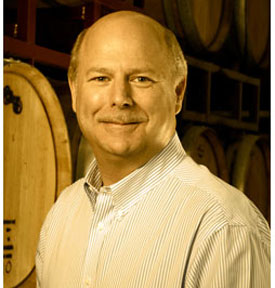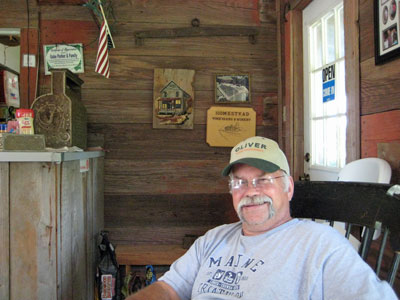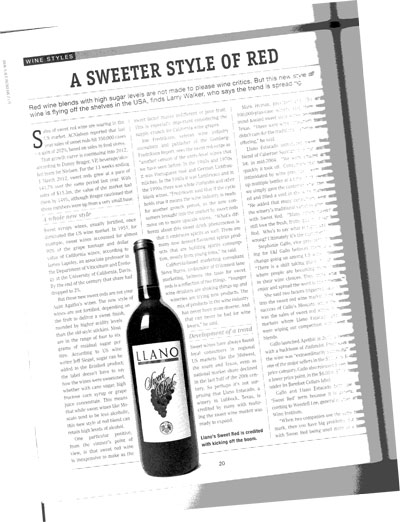Who’s Responsible for the National Sweet Red Wine Trend….Llano Estacado Winery?
Friend and wine writing colleague, Jeff Siegel – aka The Wine Curmudgeon, sent me this almost washed out PDF of an article crediting the recent national sales boom in sweet red wines to Texas’s largest premium winery, Llano Estacado. In the body of this same communication he quipped that it was Mark Hyman, Llano Estacado’s President and CEO, who should take the credit (or blame) for this revolution in wine. My hat’s off to Mark and company!
Frankly, I think this is good thing for the wine business. I’m not worried if this type of wine is not made to please the wine critics or the wine snobs that are looking for the most perfect manifestation of dry, acidic, and tannic red wine. I also don’t want to take anything away from Mark and Llano Estacado for identifying a market niche and kick starting a trend that has now gone national, and from the sounds it, has even gone international.

Why am I not worried about what the critics and snobs have to say? Well, cause it makes sense to make a lot of wine drinkers happy (and many are new to wine, as well). It also makes good business sense. Evidently, sweet red wines are flying off market shelves across the nation.
I’ve also stopped apologizing for sweet red wines in Texas, as long as they are well made, refreshing and bring a crisp finish to the table with them.
I give credit to Mark and his people at Llano Estacado and I don’t want to rain on his parade, but…I believe that there is at least one other person in Texas that deserves some credit here. It’s a guy by the name of Parker. But, it’s not the Robert Parker that people normally associate with establishing mainstream wine trends. It’s the mustachioed and smooth-topped Gabe Parker at Homestead Winery.
As I mention in my recent book, The Wineslinger Chronicles, Gabe knows what it takes for his Homestead winery to “sell” itself. It has to market wines that go with the type of foods people eat right in northeastern Texas. In Gabe’s neighborhood, the barbecue’s always pork, not beef, and it’s slathered with a sweet sauce made with brown sugar and molasses. There’s an emphasis on simple chicken dishes, but, as a rule, they’re pretty spicy. Gabe knows what kind of wines pair well with this local cuisine. They’re sweet!
Old Gabe was one of the first, if not the first, to make a commercial sweet red wine in the early days of the modern Texas wine industry (let’s say 1980’s).
When I had a chance to visit Gabe up in Ivanhoe, Texas, he told me the following:
“At the [local] Presbyterian church, they customarily have a Seder dinner at Easter time where they serve wine. One of the parishioners told me that since I had a winery, maybe I could help out and bring my wine. During the planning stages of the dinner, the matriarch of the church got in touch with me and said, ‘Oh, I hear you’re going to bring the wine. That’s real nice, but Gabe, one thing, please don’t bring that sour stuff.’ I guessed that she was referring to my dry wines.”
What Gabe did next was take some of his good red wine, put it in a five-gallon jug, and sweeten it up to about 6 percent residual sugar. Gabe and Roy Mitchell agreed that it was really pretty flat, so they juiced it up a bit on the acid side and got something that they thought was mighty tasty: sweet, crisp, and refreshing, especially when served cool.
Gabe said, “I went on over to the dinner toting this five-gallon jug with a flexible hose hangin’ out of it. It really didn’t look appealing served that way, but it worked. I also took several bottles of my dry red wine. At the end of the dinner, nearly all of the sweet red wine was gone, but most of my dry red was unopened. At the dinner, everybody was asking me when I was gonna bottle the sweet red wine so they could buy it.”
From there Gabe made up a hundred cases and called it Homestead Winery, Rose of Ivanhoe. Frankly, Gabe pondered if he could sell that much. To his surprise, the first batch of Rose of Ivanhoe sold out in a month, and right now this wine accounts for about 50 percent of his Homestead Winery sales.
Well, all I can say is gosh darn it Mark, don’t apologize to anyone for what you did to jump start this sweet red wine thing. Gabe’s not sorry for what he did, and you shouldn’t be either. If it helps you underwrite your premium wine program (that includes some mighty fine wines like your 1936 (dry) red blend, Viviano, Cellar Reserve Cabernet and Tempranillo), I’m all for it.



Sweet red wines have been around for a long time, it’s just that it’s taken CA this long to catch on – look at wines like St James’ Velvet Red, which is a perrenial bestseller. 25 years ago I worked at a winery in PA and our biggest seller was a red with an RS of 40 g/L. I totally agree with your comments about the role these wines play. My only gripe is when there is no indication on the label that they are sweet. Fortunately, as the stigma abates labels get more honest so that it’s easy for me to avoid these wines and easy for folks who do like them to get what they like.
I think it is more that the younger crowd are a bit less inclined to do what the experts say, and more what they like, and since they were bred with corn syrup and artificial sweeteners thousands of time sweeter than sugar, I personally think youth are buying what they like. An not what they are told to enjoy.